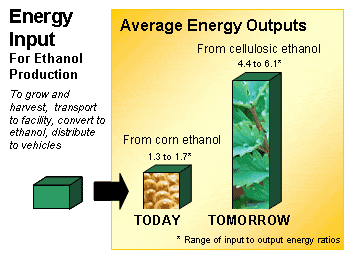Environmental Benefits
Frequently Asked Questions: Sustainability
Biofuels can provide a number of environmental advantages over conventional fossil fuels—most notably a reduction in greenhouse gas (GHG) emissions. Since the transportation sector accounts for about a third of total U.S. emissions of carbon dioxide (an abundant GHG), cleaner transportation fuels can play an important role in addressing climate change.
The level of GHG emissions associated with a particular biofuel depends on the energy used in growing and harvesting the feedstock, as well as the energy used to produce the fuel (e.g., coal, natural gas, biomass). On a full fuel-cycle basis, corn ethanol has the potential to reduce greenhouse gas emissions by as much as 52% over petroleum-based fuels. Even better, ethanol made from cellulosic feedstocks, such as switchgrass, or agricultural residues such as corn stover, has the potential to reduce greenhouse gas emissions by as much as 86%[i], compared to gasoline.
Biofuels have the added benefit of providing a "carbon sink." As crops grow to produce the feedstocks for making the biofuel, they absorb carbon dioxide from the atmosphere.

Ethanol offers additional environmental advantages over fossil fuels. It naturally biodegrades in soil and water without leaving harmful residues in the environment. [i] Because MTBE has been found carcinogenic in high concentrations, ethanol is now used as a replacement gasoline oxygenate. Ethanol provides the same oxygenate benefits, but poses little or no risk to drinking and groundwater supplies.[ii]
Publications and reports about environmental benefits can be found on this website's Information Resources page.
Reduced Fossil Fuel Inputs
When evaluating the life cycle from feedstock production to end use, production of ethanol fuel requires less fossil energy than its petroleum-based counterpart. For example, ethanol produced from corn requires about 30 to 35 percent less fossil energy is to deliver a gallon of liquid transportation fuel, on an energy equivalent basis, than is used to deliver gasoline (about 0.76-0.78 million (MM) Btu for corn versus about 1.22 MM Btu for gasoline). Fuel efficiency is increasing with improved agronomic practices, increased crop yields, improved nitrogen and water utilization, and advanced conversion technologies.
The figures for ethanol produced from lignocellulosic feedstocks – or non-starch, non-food based biomass feedstocks – are even more impressive. Cellulosic ethanol requires only ten percent of the fossil energy required to deliver a gallon of liquid transportation fuel on an energy equivalent basis compared to gasoline.
The table below illustrates fossil energy spent per Btu of useful energy produced for gasoline and various types of ethanol from biomass in each stage of the fuel production cycle. As show on a total fuel cycle basis, biofuels consume less fossil energy ber Btu produced than gasoline—with lignocellulosic resources offering the greatest potential. Realizing this potential of cellulosic ethanol production, including reduced GHG emissions and fossil-fuel dependence, is a primary goal of the Biomass Program.

| Process Stage | Corn stover | Corn w/ Co product | Forest - Woody Residue | Gasoline |
|---|---|---|---|---|
| Feedstock | 0.06 | 0.28 | 0.06 | 0.02 |
| Transportation | 0.10 | 0.03 | 0.04 | 0.01 |
| Refinery | 0.00 | 0.43 | 0.05 | 0.18 |
| Distribution | 0.17 | 0.02 | 0.02 | 0.05 |
| End Use | 0.00 | 0.00 | 0.00 | 0.95 |
| Total | 0.09 | 0.76 | 0.16 | 1.22 |
[i] Ask a Scientist: Biodegradability. ANL.
[ii] Data for Reduction in Fossil Energy Input and Reduction in GHGs sections from Wang, M.Q., et.al.; "Ethanol: The Complete Energy Life-Cycle Picture"; August 2006, Argonne National Laboratory and Farrell, A.E., et.al, "Ethanol Can Contribute to Energy and Environmental Goals"; Science Magazine, January 27, 2006.
[iii] Wang, et al., GREET 1.7 Demonstrations, Argonne National Laboratory, 2005.



















